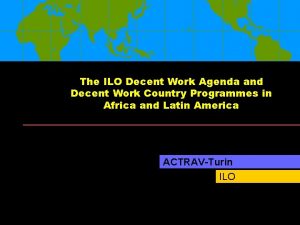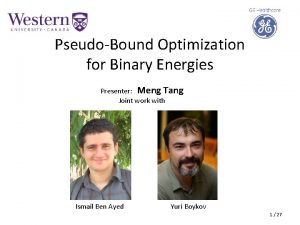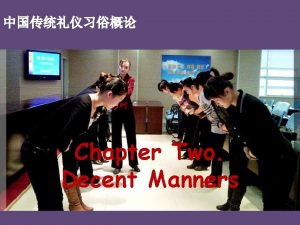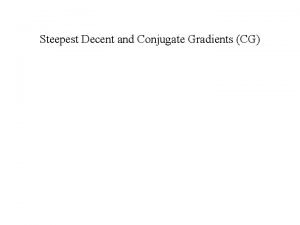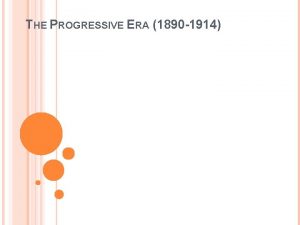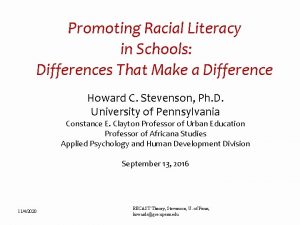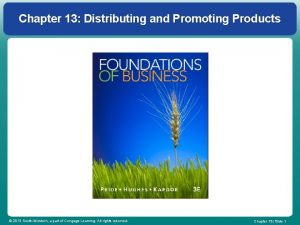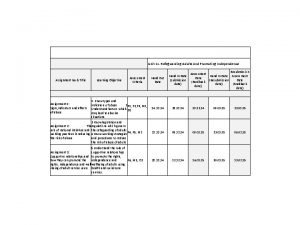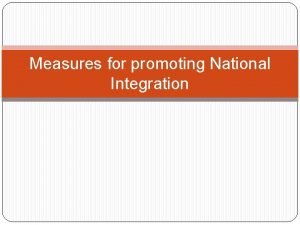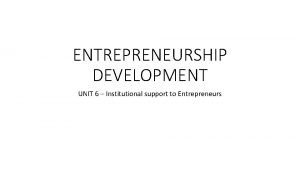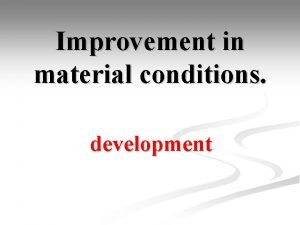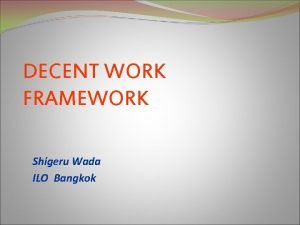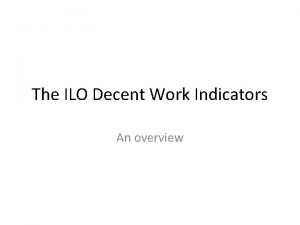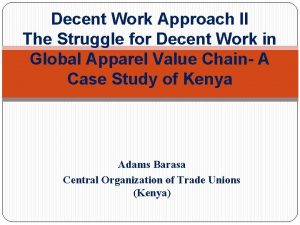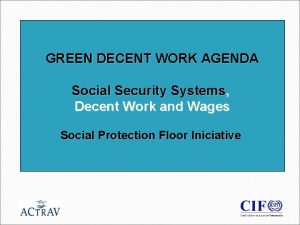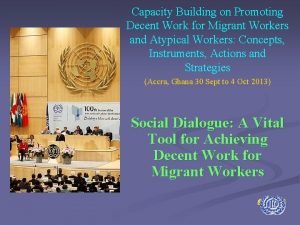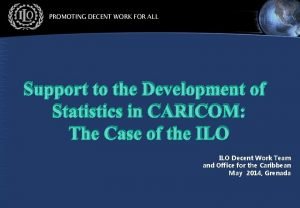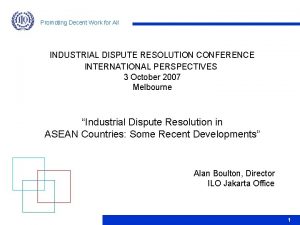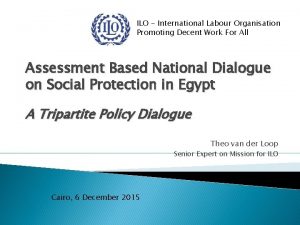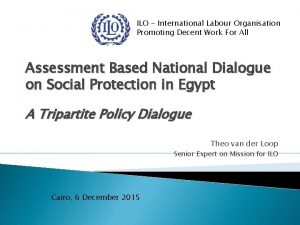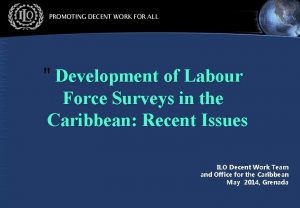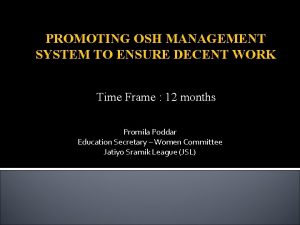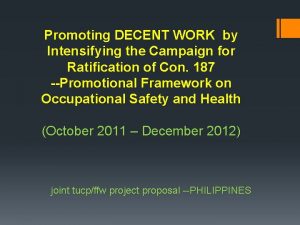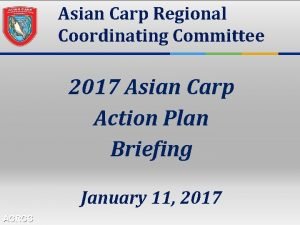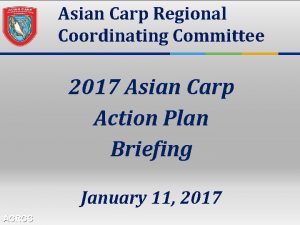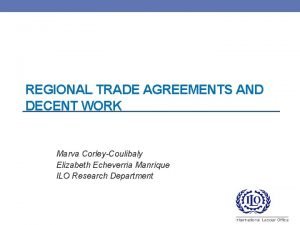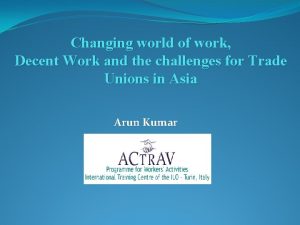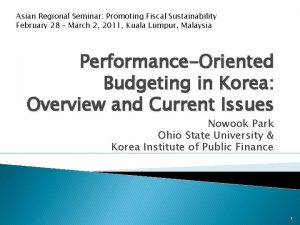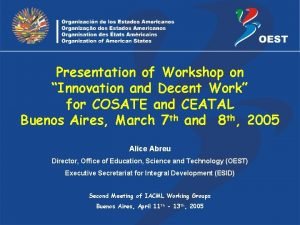KLFACTRAVITCILO Asian Regional Workshop on Promoting Decent Work
































- Slides: 32

KLF-ACTRAV/ITC-ILO Asian Regional Workshop on Promoting Decent Work in MNEs & Their Supply Chains 19 Nov. 2014 Sung-Jin Kim KOREA LABOR FOUNDATION(KLF) Industrial Relations in MNEs (Focusing on Korean Cases)

Contents 1. Part I Industrial Relations 2. Part II Multinational Enterprises 3. Part III Industrial Relations in Korea 4. Part IV Industrial Relations of Korean MNEs 5. Part V Conclusion

Part I Industrial Relations

What is Industrial Relations? Industry – any productive activity(land/natural resources, capital/money & labor) Relations – relationship → Relationship between the employer(owner) and his/her employees within the industry Management and employees Management and trade union(s)

Labor Market Buyers(employers) and sellers(workers) Demand & supply in a free market Equilibrium wage & equilibrium employment Currently, labor market is demand/buyers’ market; labor of supply>demand for labor

Government Intervention Market failure Labor is not a commodity. Thus, should be protected by labor laws and regulations Minimum wage fixation But, challenging trend of labor market flexibility or deregulation

Conditions of Employment Determined upon the mutual agreement on a equal footing Forms of employment: direct vs. indirect; regular workers vs. irregular, contract, dispatched workers; full-time vs. part-time Wages (including minimum wage), working hours (including overtime) & rest, holidays & paid leave Industrial safety & health

Role of Trade Unions Formation of trade unions: representation Collective bargaining: most representative trade unions Collective agreements, better than laws and regulations Collectively protecting the rights and interests of workers

Industrial Relations in Private & Public Sectors More restriction imposed on the government and public sectors such as government ministries & agencies, hospitals, electricity, gas, water, railway, teachers, etc. , but Higher unionization rate: government sector> public sector>private sector

Part II Multinational Enterprises

What is the MNE? Multinational enterprises (MNE) are companies that own or control productions of goods or services in one or more countries other than the home country.

How many multinational companies are there in the world? According to the World Investment Report 2009, published by the UNCTAD (United Nations Conference on Trade and Development) 889, 416 multinational companies (MNCs) around the world 82, 053 parent corporations 807, 363 affiliates

Exports by affiliates of parent corporations are estimated to account for about 1/3 of total world exports of goods and services Number of people employed by affiliates of parent corporations worldwide totaled about 77 million in 2008 And they are increasing year after year.

Employment Zero Sum Game? Investment in the hosting countries contributes to the employment creation & technology advance. Job shifting from investing country to hosting country?

MNEs & Race to the Bottom Globalized economy Greed and competition Production base for exports Inequality Working poor Minimum wage vs. living wage Long working hours

Brakes on Unbridled Greed & Abuse ILO Conventions & Recommendations(www. ilo. org) ILO MNE Declaration(www. ilo. org) OECD Guidelines for Multinationals(www. oecd. org) UN Global Compact; human rights, labor, environment, anticorruption(www. unglobalcompact. org) Global Reporting Initiative(GRI)(www. globalreporting. org) ISO 26000(social responsibility)(www. iso. org)

Corporate Sustainability Economi c Company for the future Social Environment al

Stakeholders Employees – wages & decent living Shareholders - dividends Supply chains; Partner companies/Vendors – co-prosperity Government(central & local) - tax Community – growth & development, environment Customers - satisfaction

Value Chains & Supply Chains Materials Waste/Recycling Service Production Distribution/Sales

Global Code of Conduct Ethical management; integrity & transparency Corporate social responsibility(CSR); respect & contribution Creating shared value(CSV); sharing

Part III Industrial Relations in Korea

Industrial Relations in Korea Before 1987 - under the control of power After 1987 – democratization, democratic and independent trade unions Higher demands on wage and working conditions - unstable industrial relations Lack of mutual respect and trust between employers and employees – liability up until today Joining the ILO in 1991 Joining the OECD in 1996

Asian financial crisis in 1997 & its impact on labor market in Korea – the mirage of lifetime employment; layoffs and the increase of precarious jobs Improvement of trade union rights Deterioration of employment security Ratification of Core ILO Convention Nos: 100, 111, 138, 182 No ratification on Nos: 29, 87, 98, 105

Employees & Supply Chains as Major Stakeholders (Y Company) Human rights protection education including prevention of sexual harassment Trade union rights; unionization rate(99. 8%) & collective bargaining Prohibition of forced labor; labor management agreement before overtime & holiday work, ban on night work for pregnant workers Prohibition of child labor under the age of 18 Prohibition of discrimination; equal pay for all newly recruited graduates Code of conduct/ethics for supply chains & monitoring on their labor practices

Part IV Industrial Relations of Korean MNEs

Industrial Relations of Korean MNEs Affecting factors CEO’s perspective of parent corporations toward trade unions Laws and regulations in the hosting countries Trade union movement in the hosting countries Level of social dialogues in the hosting countries

Case I. A company ‘No union’ management philosophy Consultation only But, trade unions are conceded in China, Brazil as exceptional cases

Case 2. B company Union recognized, but Union corporatism favored Lack of mutual trust & respect

Case 3. C company Union recognized as a partner Collective agreement Equal participation in labor-management council and OSH committee

Case 4. D company(vendors) No union in the head office which is not engaged in the production, but rather as a controlling tower of the global production Unions recognized due to the global pressure from the global brands/buyers Indonesia, Bangladesh, Cambodia, Vietnam, etc.

Part V Conclusion Education for workers & organizing Union capacity building for better and effective social dialogue at all levels Fight for decent jobs with living wages and adequate working conditions Solidarity support from the parent company unions or trade union movement of the investing country Getting connected(communication) globally

International survey and compliance monitoring Promoting global framework agreements between MNEs and GUFs Not a single Korean MNE yet to reach the GFA.
 Ilo decent work agenda
Ilo decent work agenda Decent hospital
Decent hospital Coordinate decent
Coordinate decent Playing a decent game of table tennis
Playing a decent game of table tennis Coordinate decent
Coordinate decent Decent manners
Decent manners Steepest decent
Steepest decent Decent with modification
Decent with modification When was the progressive era? *
When was the progressive era? * Promoting services and educating customers
Promoting services and educating customers Promoting alternative thinking strategies
Promoting alternative thinking strategies Chapter 1 lesson 4 promoting health and wellness
Chapter 1 lesson 4 promoting health and wellness Do. 27 s. 2015 promoting family earthquake preparedness
Do. 27 s. 2015 promoting family earthquake preparedness Chapter 1 understanding health and wellness lesson 4
Chapter 1 understanding health and wellness lesson 4 Promoting racial literacy in schools
Promoting racial literacy in schools Lesson 4 promoting health and wellness
Lesson 4 promoting health and wellness Methods of promoting intrapreneurship leaving cert
Methods of promoting intrapreneurship leaving cert Keeping an infant safe and well section 7-3
Keeping an infant safe and well section 7-3 Promoting excellence in dementia care
Promoting excellence in dementia care Deontological moral theory
Deontological moral theory Chapter 7 promoting health and wellness
Chapter 7 promoting health and wellness Chapter 30 promoting bowel elimination
Chapter 30 promoting bowel elimination Chapter 13 distributing and promoting products
Chapter 13 distributing and promoting products Promoting services and educating customers
Promoting services and educating customers Health promoting schools model
Health promoting schools model Promoting active participation
Promoting active participation Promoting a positive health and safety culture
Promoting a positive health and safety culture Unit 11 safeguarding adults and promoting independence
Unit 11 safeguarding adults and promoting independence Promoting national integration
Promoting national integration Institutional services to entrepreneurs
Institutional services to entrepreneurs Health promoting school
Health promoting school Japan's principal asset for promoting development was
Japan's principal asset for promoting development was Health and wellness vocabulary
Health and wellness vocabulary
